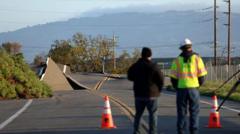The term "bomb cyclone" is coined from the meteorological phenomenon where the air pressure plummets sharply in the storm's core, causing rapid intensification. The last significant instance of a bomb cyclone occurred in California in March 2023.
Regions in the northwest have already begun to experience the turmoil, with Seattle reporting powerful wind gusts. NOAA forecasts that mountain ranges in the Pacific Northwest may receive heavy, wet snow, accumulating between 2-3 inches (5-8cm) per hour, along with wind speeds of up to 65 mph (29mps). Travelers are cautioned about potential whiteout conditions, which will complicate travel plans. Certain areas could see snow totals reach 10-20 inches (25-50cm), coinciding with predictions of power outages, downed vegetation, and high surf along coastlines.
Northern California and southwest Oregon are expected to face the most intense rainfall, raising red flags for mudslides, based on NOAA's outlooks. The National Weather Service has responded by issuing a series of winter weather alerts, foreshadowing the dangers of flooding, challenging travel conditions, electricity outages, and damage from fallen trees as the storm intensifies.
A bomb cyclone is characterized by a central air pressure drop of at least 24 millibars within a 24-hour period. While this storm is a stark reminder of severe winter conditions typical for this time of year, its convergence with an atmospheric river could lead to unprecedented challenges. BBC Weather's forecast highlights that the storm will initially impact the northwest coast before unleashing prolonged heavy rains and significant flood threats.
As the situation unfolds, residents are encouraged to remain informed about evolving weather updates, ensuring safety as this formidable storm system approaches.
Regions in the northwest have already begun to experience the turmoil, with Seattle reporting powerful wind gusts. NOAA forecasts that mountain ranges in the Pacific Northwest may receive heavy, wet snow, accumulating between 2-3 inches (5-8cm) per hour, along with wind speeds of up to 65 mph (29mps). Travelers are cautioned about potential whiteout conditions, which will complicate travel plans. Certain areas could see snow totals reach 10-20 inches (25-50cm), coinciding with predictions of power outages, downed vegetation, and high surf along coastlines.
Northern California and southwest Oregon are expected to face the most intense rainfall, raising red flags for mudslides, based on NOAA's outlooks. The National Weather Service has responded by issuing a series of winter weather alerts, foreshadowing the dangers of flooding, challenging travel conditions, electricity outages, and damage from fallen trees as the storm intensifies.
A bomb cyclone is characterized by a central air pressure drop of at least 24 millibars within a 24-hour period. While this storm is a stark reminder of severe winter conditions typical for this time of year, its convergence with an atmospheric river could lead to unprecedented challenges. BBC Weather's forecast highlights that the storm will initially impact the northwest coast before unleashing prolonged heavy rains and significant flood threats.
As the situation unfolds, residents are encouraged to remain informed about evolving weather updates, ensuring safety as this formidable storm system approaches.




















